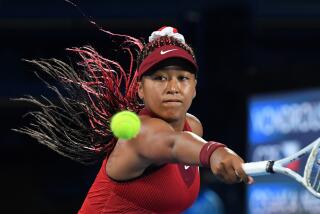It Happens on Quiet Day
- Share via
WIMBLEDON, England — A time-honored tradition--the fishing expedition--is played out almost every year at Wimbledon. A player is asked a leading question, makes an innocuous observation, and suddenly, headlines are created.
This usually happens on a quiet day with no upsets. Monday was like that on the women’s side for the most part. There was one small break in form in the fourth round when No. 11-seeded Daniela Hantuchova of Slovakia defeated No. 7 Jelena Dokic of Yugoslavia, 6-4, 7-5. But that wasn’t much of a surprise because Dokic had lost to Hantuchova in their two previous matches.
Because a rain delay lasting almost two hours pushed back the schedule, No. 3 Jennifer Capriati could not finish her match against Eleni Daniilidou of Greece. Capriati won the first set, 6-1, and lost the second, 3-6, when play was suspended. The third set was rescheduled for today.
Two-time defending champion and No. 1 Venus Williams beat No. 16 Lisa Raymond, 6-1, 6-2; No. 2 Serena Williams defeated Chanda Rubin, 6-3, 6-3, and No. 4 Monica Seles dispatched Tamarine Tanasurgarn of Thailand, 6-2, 6-2.
Also advancing in straight sets were No. 6 Justine Henin of Belgium, Elena Likhovtseva of Russia and No. 9 Amelie Mauresmo of France. All in all, it was a day with little suspense and drama.
And so, after Mauresmo beat qualifier Laura Granville, 6-2, 6-2, one reporter asked the 21-year-old American whether she had heard that Mauresmo used steroids.
“I’ve heard those rumors too, but she works really hard,” said Granville, who has played almost exclusively on a smaller circuit, below the WTA tour. “I’m not sure how she can get that strong. But it’s a sign of where women’s tennis is going.”
Granville wasn’t even yet at Stanford when Mauresmo made her breakthrough by reaching the 1999 Australian Open final. The unfair attacks on Mauresmo in regard to her physique and sexuality, primarily by other players, started there. Mauresmo is hardly the biggest or strongest woman on the tour. She has never tested positive for a banned substance, and starting this year, the leading French players are having their blood screened three times a year, in order to monitor any variances.
At the Grand Slams, players are tested from the quarterfinals on, and randomly beforehand. The WTA tour has in-competition testing at its tournaments, and the tour’s general counsel and vice president of legal and business affairs, Tandy O’Donoghue said that almost every top player--those in the top 25--has been tested numerous times last year.
“One-hundred-twenty different players have been tested, and I’m being conservative,” added O’Donoghue.
One of the big issues and a point of contention is the absence of random, out-of-competition testing on the WTA tour. For the men, the ATP is attempting to increase its out-of-competition testing, which had been relatively light in numbers.
“It’s difficult. But there are no excuses,” said O’Donoghue. “We want to do it. We plan to do it. We hope to do some in 2002, We plan to do some in 2003.”
More to Read
Go beyond the scoreboard
Get the latest on L.A.'s teams in the daily Sports Report newsletter.
You may occasionally receive promotional content from the Los Angeles Times.











